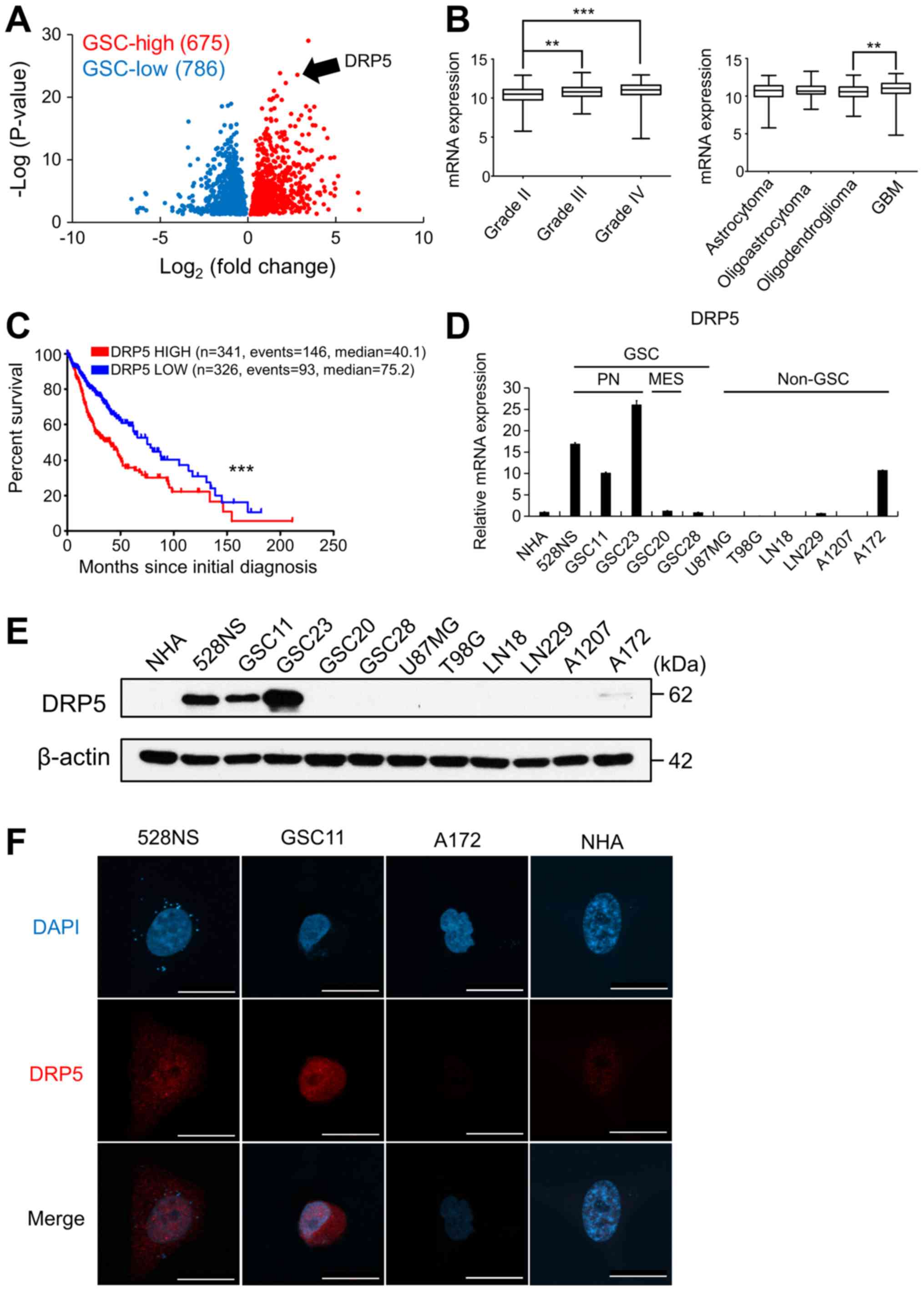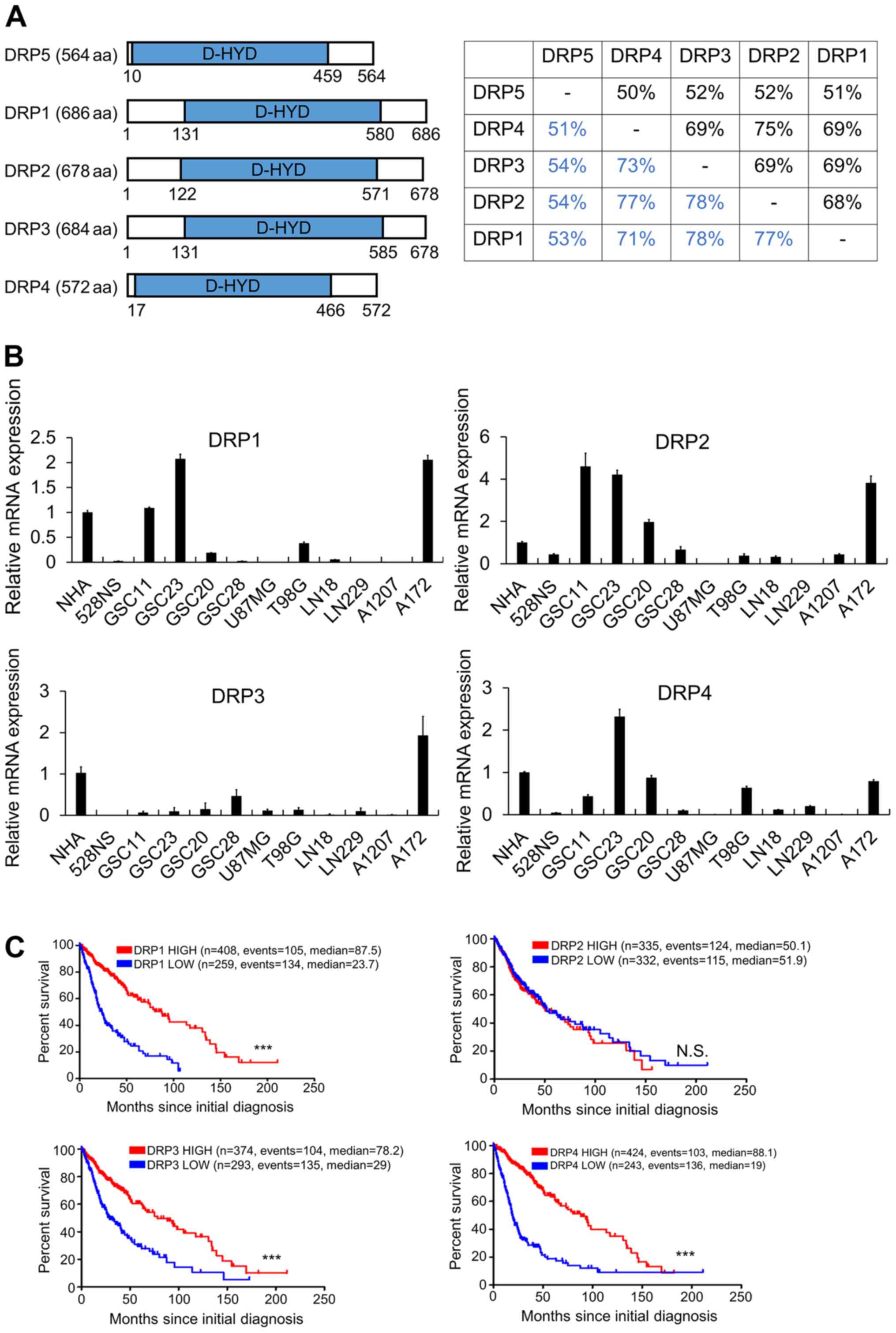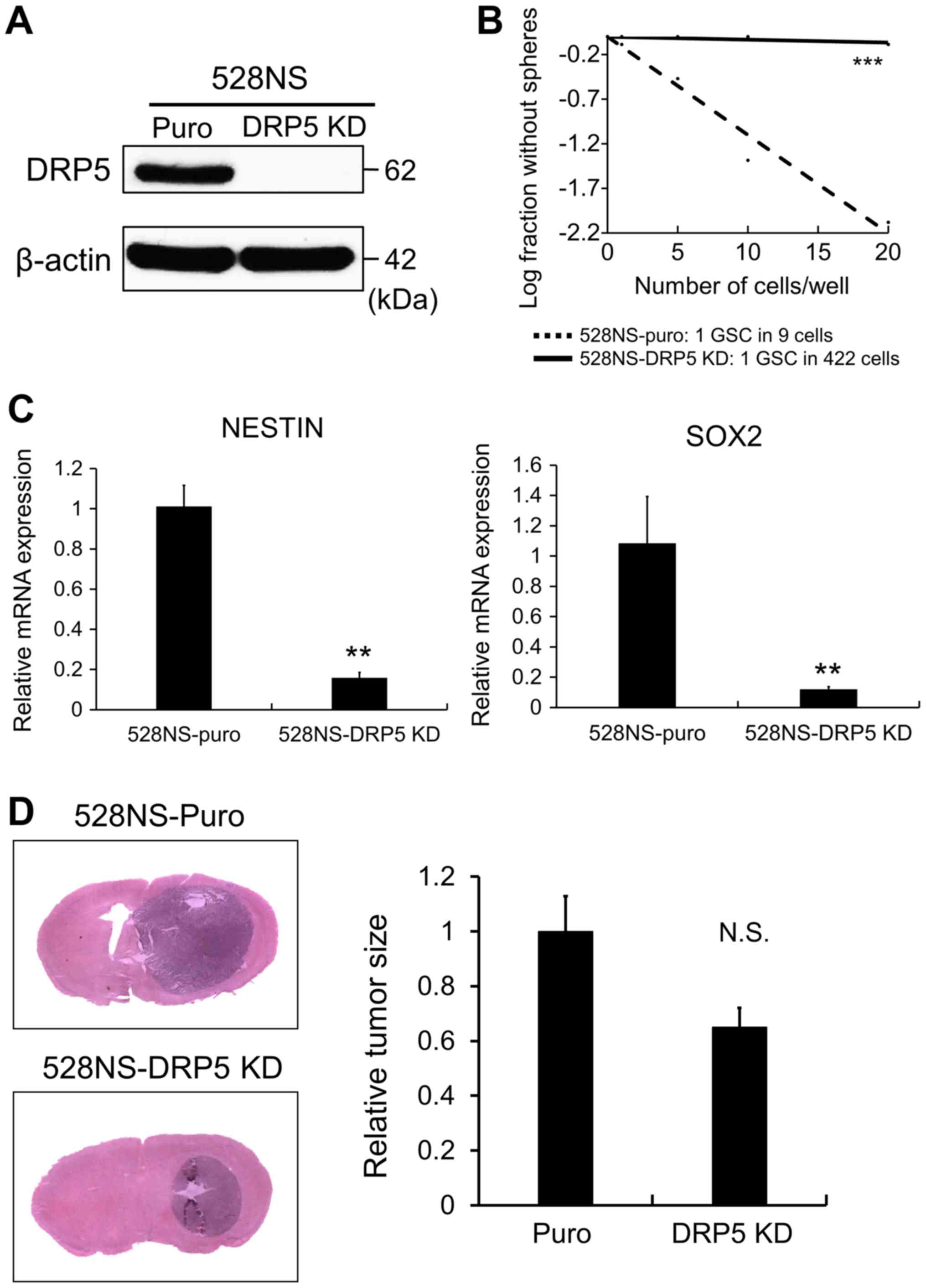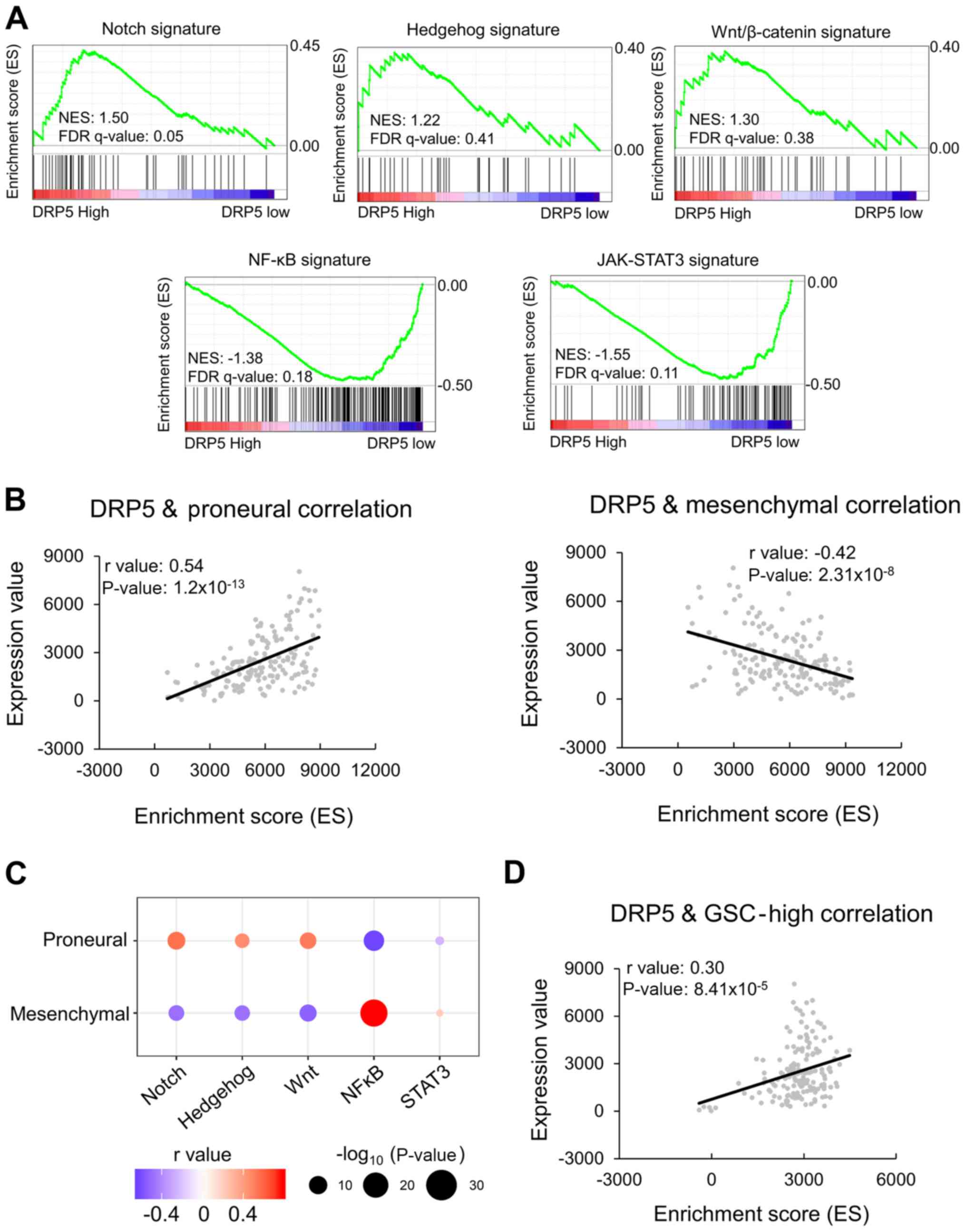|
1
|
Mazaris P, Hong X, Altshuler D, Schultz L,
Poisson LM, Jain R, Mikkelsen T, Rosenblum M and Kalkanis S: Key
determinants of short-term and long-term glioblastoma survival: A
14-year retrospective study of patients from the Hermelin Brain
Tumor Center at Henry Ford Hospital. Clin Neurol Neurosurg.
120:103–112. 2014. View Article : Google Scholar : PubMed/NCBI
|
|
2
|
Porter KR, McCarthy BJ, Freels S, Kim Y
and Davis FG: Prevalence estimates for primary brain tumors in the
United States by age, gender, behavior and histology. Neuro Oncol.
12:520–527. 2010. View Article : Google Scholar : PubMed/NCBI
|
|
3
|
Omuro A and DeAngelis LM: Glioblastoma and
other malignant gliomas: A clinical review. JAMA. 310:1842–1850.
2013. View Article : Google Scholar : PubMed/NCBI
|
|
4
|
Dobelbower MC, Burnett Iii OL, Nordal RA,
Nabors LB, Hyatt MD and Fiveash JB: Patterns of failure for
glioblastoma multiforme following concurrent radiation and
temozolomide. J Med Imaging Radiat Oncol. 55:77–81. 2011.
View Article : Google Scholar : PubMed/NCBI
|
|
5
|
Neman J and Jandial R: Decreasing glioma
recurrence through adjuvant cancer stem cell inhibition. Biologics.
4:157–162. 2010.PubMed/NCBI
|
|
6
|
Reya T, Morrison SJ, Clarke MF and
Weissman IL: Stem cells, cancer, and cancer stem cells. Nature.
414:105–111. 2001. View
Article : Google Scholar : PubMed/NCBI
|
|
7
|
Lathia JD, Mack SC, Mulkearns-Hubert EE,
Valentim CL and Rich JN: Cancer stem cells in glioblastoma. Genes
Dev. 29:1203–1217. 2015. View Article : Google Scholar : PubMed/NCBI
|
|
8
|
Chen J, Li Y, Yu TS, McKay RM, Burns DK,
Kernie SG and Parada LF: A restricted cell population propagates
glioblastoma growth after chemotherapy. Nature. 488:522–526. 2012.
View Article : Google Scholar : PubMed/NCBI
|
|
9
|
Xie Q, Mittal S and Berens ME: Targeting
adaptive glioblastoma: An overview of proliferation an invasion.
Neuro Oncol. 16:1575–1584. 2014. View Article : Google Scholar : PubMed/NCBI
|
|
10
|
Kanabur P, Guo S, Simonds GR, Kelly DF,
Gourdie RG, Verbridge SS and Sheng Z: Patient-derived glioblastoma
stem cells respond differentially to targeted therapies.
Oncotarget. 7:86406–86419. 2016. View Article : Google Scholar : PubMed/NCBI
|
|
11
|
Jackson M, Hassiotou F and Nowak A:
Glioblastoma stem-like cells: At the root of tumor recurrence and a
therapeutic target. Carcinogenesis. 36:177–185. 2015. View Article : Google Scholar : PubMed/NCBI
|
|
12
|
Wang Q, Hu B, Hu X, Kim H, Squatrito M,
Scarpace L, deCarvalho AC, Lyu S, Li P, Li Y, et al: Tumor
evolution of glioma-intrinsic gene expression subtypes associates
with immunological changes in the microenvironment. Cancer Cell.
32:42–56.e6. 2017. View Article : Google Scholar : PubMed/NCBI
|
|
13
|
Schmidt EF and Strittmatter SM: The CRMP
family of proteins and their role in Sema3A signaling. Adv Exp Med
Biol. 600:1–11. 2007. View Article : Google Scholar : PubMed/NCBI
|
|
14
|
Quach TT, Honnorat J, Kolattukudy PE,
Khanna R and Duchemin AM: CRMPs: Critical molecules for neurite
morphogenesis and neuropsychiatric diseases. Mol Psychiatry.
20:1037–1045. 2015. View Article : Google Scholar : PubMed/NCBI
|
|
15
|
Charrier E, Reibel S, Rogemond V, Aguera
M, Thomasset N and Honnorat J: Collapsin response mediator proteins
(CRMPs): Involvement in nervous system development and adult
neurodegenerative disorders. Mol Neurobiol. 28:51–64. 2003.
View Article : Google Scholar : PubMed/NCBI
|
|
16
|
Tan F, Thiele CJ and Li Z: Collapsin
response mediator proteins: Potential diagnostic and prognostic
biomarkers in cancers (Review). Oncol Lett. 7:1333–1340. 2014.
View Article : Google Scholar : PubMed/NCBI
|
|
17
|
Zheng Y, Sethi R, Mangala LS, Taylor C,
Goldsmith J, Wang M, Masuda K, Karaminejadranjbar M, Mannion D,
Miranda F, et al: Tuning microtubule dynamics to enhance cancer
therapy by modulating FER-mediated CRMP2 phosphorylation. Nat
Commun. 9:4762018. View Article : Google Scholar : PubMed/NCBI
|
|
18
|
Yang Y, Jiang Y, Xie D, Liu M, Song N, Zhu
J, Fan J and Zhu C: Inhibition of cell-adhesion protein DPYSL3
promotes metastasis of lung cancer. Respir Res. 19:412018.
View Article : Google Scholar : PubMed/NCBI
|
|
19
|
Nagano H, Hashimoto N, Nakayama A, Suzuki
S, Miyabayashi Y, Yamato A, Higuchi S, Fujimoto M, Sakuma I, Beppu
M, et al: p53-inducible DPYSL4 associates with mitochondrial
supercomplexes and regulates energy metabolism in adipocytes and
cancer cells. Proc Natl Acad Sci USA. 115:8370–8375. 2018.
View Article : Google Scholar : PubMed/NCBI
|
|
20
|
Moutal A, Honnorat J, Massoma P,
Desormeaux P, Bertrand C, Malleval C, Watrin C, Chounlamountri N,
Mayeur ME, Besancon R, et al: CRMP5 controls glioblastoma cell
proliferation and survival through Notch-dependent signaling.
Cancer Res. 75:3519–3528. 2015. View Article : Google Scholar : PubMed/NCBI
|
|
21
|
Wang L, Liu W, Tang H, Xie X, Zou C, Wang
Y, Gao Z and Yin J: DRP5 is involved in cancer cell growth and
predicts poor prognosis in human osteosarcoma. Cancer Med.
6:982–993. 2017. View Article : Google Scholar : PubMed/NCBI
|
|
22
|
Dubey D, Lennon VA, Gadoth A, Pittock SJ,
Flanagan EP, Schmeling JE, McKeon A and Klein CJ: Autoimmune CRMP5
neuropathy phenotype and outcome defined from 105 cases. Neurology.
90:e103–e110. 2018. View Article : Google Scholar : PubMed/NCBI
|
|
23
|
Petit V, Massonnet G, Maciorowski Z,
Touhami J, Thuleau A, Nemati F, Laval J, Cahteau-Joubert S, Servely
JL, Vallerand D, et al: Optimization of tumor xenograft
dissociation for the profiling of cell surface markers and nutrient
transporters. Lab Invest. 93:611–621. 2013. View Article : Google Scholar : PubMed/NCBI
|
|
24
|
Livak KJ and Schmittgen TD: Analysis of
relative gene expression data using real-time quantitative PCR and
the 2(-Delta Delta C(T)) method. Methods. 25:402–408. 2001.
View Article : Google Scholar : PubMed/NCBI
|
|
25
|
Lee J, Kotliarova S, Kotliarov Y, Li A, Su
Q, Donin NM, Pastorino S, Purow BW, Christopher N, Zhang W, et al:
Tumor stem cells derived from glioblastomas cultured in bFGF and
EGF more closely mirror the phenotype and genotype of primary
tumors than do serum-cultured cell lines. Cancer Cell. 9:391–403.
2006. View Article : Google Scholar : PubMed/NCBI
|
|
26
|
Mao P, Joshi K, Li J, Kim SH, Li P,
Santana-Santos L, Luthra S, Chandran UR, Benos PV, Smith L, et al:
Mesenchymal glioma stem cells are maintained by activated
glycolytic metabolism involving aldehyde dehydrogenase 1A3. Proc
Natl Acad Sci USA. 110:8644–8649. 2013. View Article : Google Scholar : PubMed/NCBI
|
|
27
|
Brot S, Malleval C, Benetollo C, Auger C,
Meyronet D, Rogemond V, Honnorat J and Moradi-Ameli M:
Identification of a new CRMP5 isoform present in the nucleus of
cancer cells and enhancing their proliferation. Exp Cell Res.
319:588–599. 2013. View Article : Google Scholar : PubMed/NCBI
|
|
28
|
Tan M, Cha C, Ye Y, Zhang J, Li S, Wu F,
Gong S and Guo G: CRMP4 and CRMP2 interact to coordinate
cytoskeleton dynamics, regulating growth cone development and axon
elongation. Neural Plast. 2015:9474232015. View Article : Google Scholar : PubMed/NCBI
|
|
29
|
Ponnusamy R and Lohkamp B: Insights into
the oligomerization of CRMPs: Crystal structure of human collapsin
response mediator protein 5. J Neurochem. 125:855–868. 2013.
View Article : Google Scholar : PubMed/NCBI
|
|
30
|
Bhat KPL, Balasubramaniyan V, Vaillant B,
Ezhilarasan R, Hummelink K, Hollingsworth F, Wani K, Heathcock L,
James JD, Goodman LD, et al: Mesenchymal differentiation mediated
by NF-κB promotes radiation resistance in glioblastoma. Cancer
Cell. 24:331–346. 2013. View Article : Google Scholar : PubMed/NCBI
|
|
31
|
Carro MS, Lim WK, Alvarez MJ, Bollo RJ,
Zhao X, Snyder EY, Sulman EP, Anne SL, Doetsch F, Colman H, et al:
The transcriptional network for mesenchymal transformation of brain
tumours. Nature. 463:318–325. 2010. View Article : Google Scholar : PubMed/NCBI
|
|
32
|
Barbato L, Bocchetti M, Di Biase A and
Regad T: Cancer stem cells and targeting strategies. Cells.
8:E9262019. View Article : Google Scholar : PubMed/NCBI
|
|
33
|
Kwon SM, Kang SH, Park CK, Jung S, Park
ES, Lee JS, Kim SH and Woo HG: Recurrent glioblastomas reveal
molecular subtypes associated with mechanistic implications of
drug-resistance. PLoS One. 10:e01405282015. View Article : Google Scholar : PubMed/NCBI
|
|
34
|
Dagogo-Jack I and Shaw AT: Tumor
heterogeneity and resistance to cancer therapies. Nat Rev Clin
Oncol. 15:81–94. 2018. View Article : Google Scholar : PubMed/NCBI
|
|
35
|
Patel AP, Tirosh I, Trombetta JJ, Shalek
AK, Gillespie SM, Wakimoto H, Cahill DP, Nahed BV, Curry WT,
Martuza RL, et al: Single-cell RNA-seq highlights intratumoral
heterogeneity in primary glioblastoma. Science. 344:1396–1401.
2014. View Article : Google Scholar : PubMed/NCBI
|
|
36
|
Dai X, Liao K, Zhuang Z, Chen B, Zhou Z,
Zhou S, Lin G, Zhang F, Lin Y, Miao Y, et al: AHIF promotes
glioblastoma progression and radioresistance via exosomes. Int J
Oncol. 54:261–270. 2019.PubMed/NCBI
|
|
37
|
Qian Z, Ren L, Wu D, Yang X, Zhou Z, Nie
Q, Jiang G, Xue S, Weng W, Qiu Y and Lin Y: Overexpression of
FoxO3a is associated with glioblastoma progression and predicts
poor patient prognosis. Int J Cancer. 140:2792–2804. 2017.
View Article : Google Scholar : PubMed/NCBI
|
|
38
|
Luo K and Zhuang K: High expression of
PCBP2 is associated with proression and poor prognosis in patients
with glioblastoma. Biomed Pharmacother. 94:659–665. 2017.
View Article : Google Scholar : PubMed/NCBI
|
|
39
|
Martínez-Murillo R and Martínez A:
Standardization of an orthotopic mouse brain tumor model following
transplantation of CT-2A astrocytoma cells. Histol Histopathol.
22:1309–1326. 2007.PubMed/NCBI
|
|
40
|
Huang YH, Ning ZJ and Huang CY: Crystal
structure of dihydropyrimidinase in complex with anticancer drug
5-fluorouracil. Biochem Biophys Res Commun. 519:160–165. 2019.
View Article : Google Scholar : PubMed/NCBI
|
|
41
|
Fukada M, Watakabe I, Yuasa-Kawada J,
Kawachi H, Kuroiwa A, Matsuda A and Noda M: Molecular
characterization of CRMP5, a novel member of the collapsin response
mediator protein family. J Biol Chem. 275:37957–37965. 2000.
View Article : Google Scholar : PubMed/NCBI
|


















